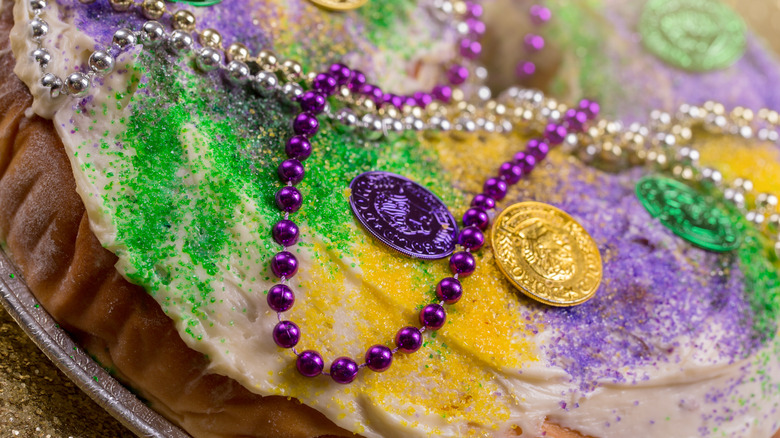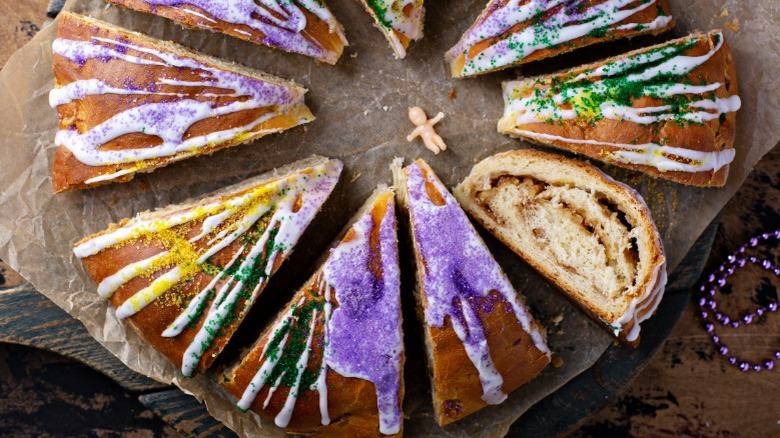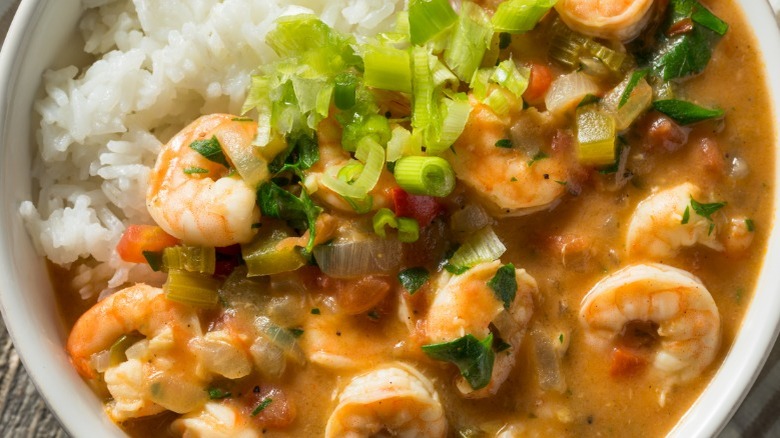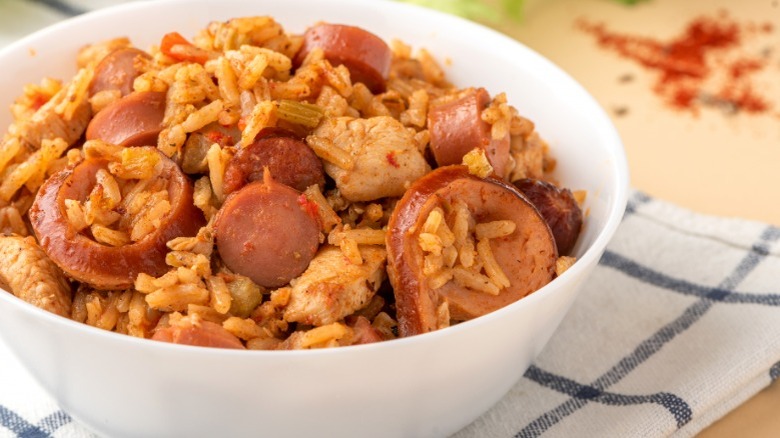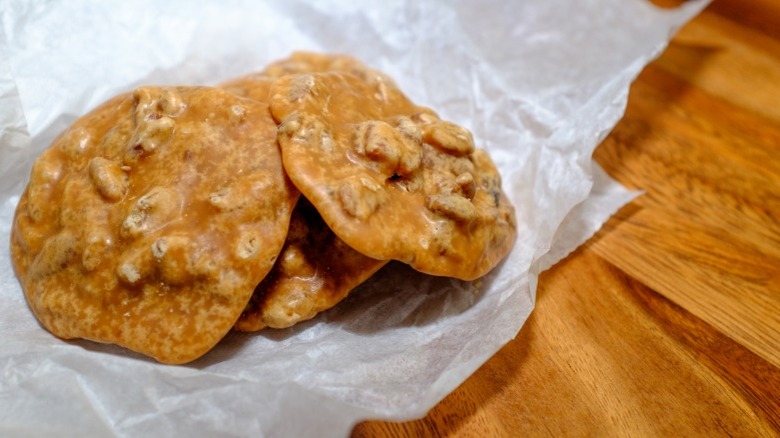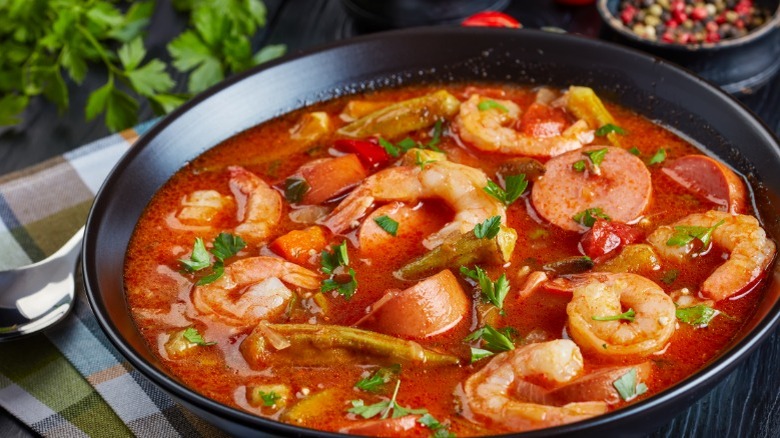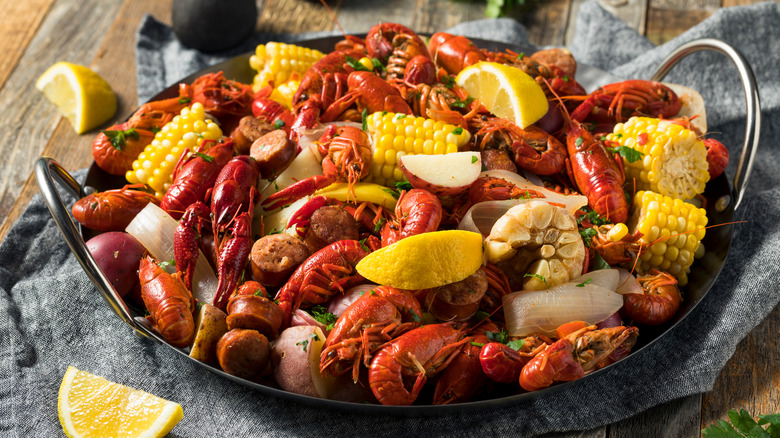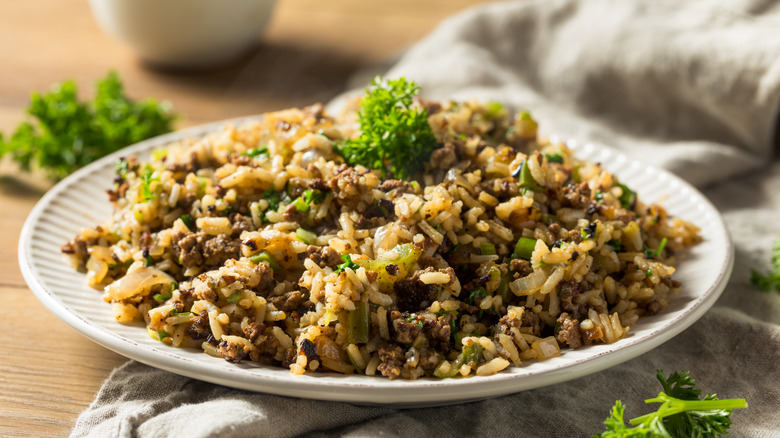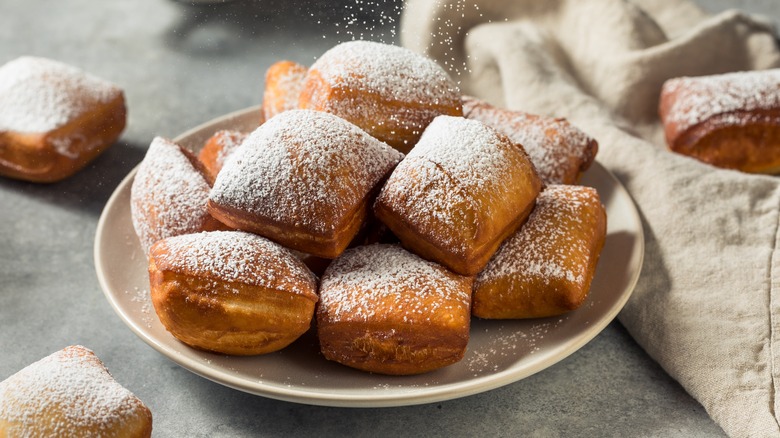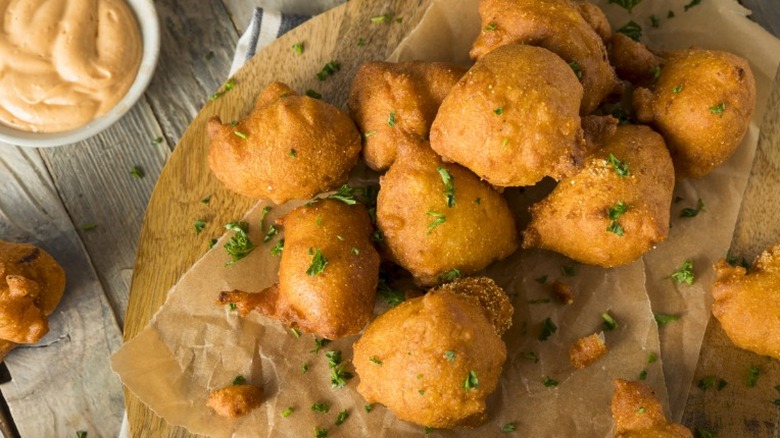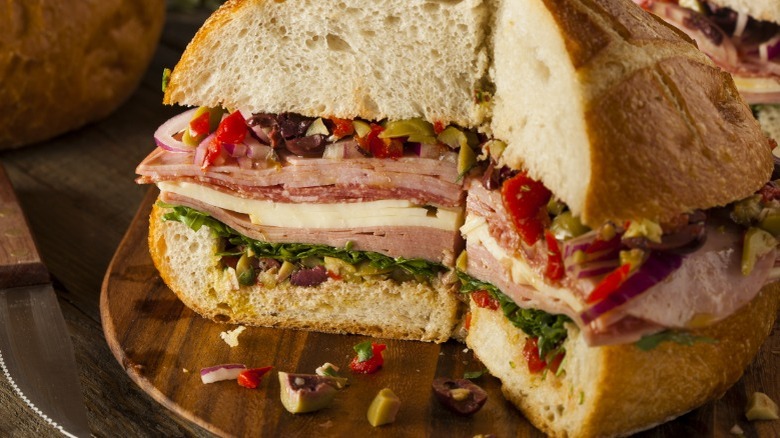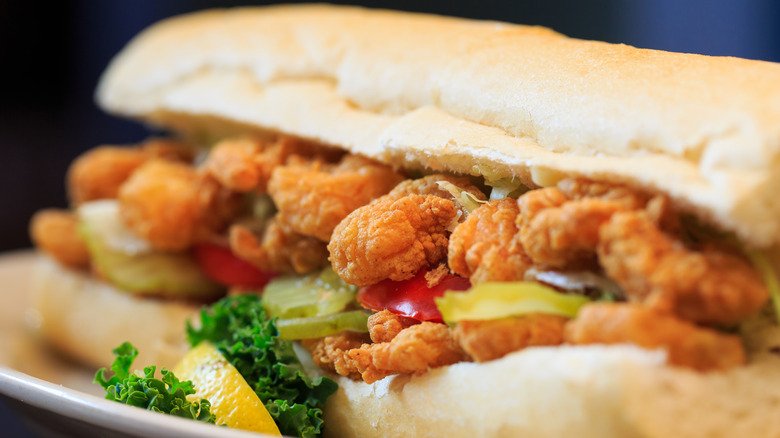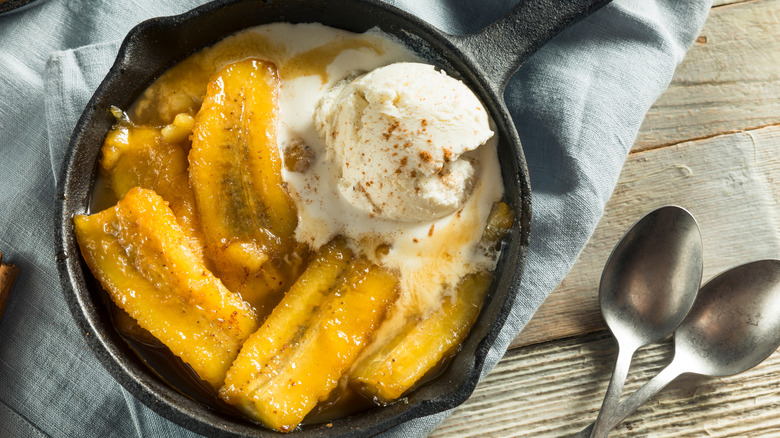Mardi Gras Foods You Need To Try Before You Die
If you're looking for an excuse to celebrate great food, then Mardi Gras, the Tuesday in February that falls before Ash Wednesday, is perfect. What other holiday encourages outright indulgence to prepare for the period of abstinence that follows? Whether you adhere to the religious traditions of the celebration known affectionately around the world as Fat Tuesday or you just love an excuse to eat big and go home happy, Mardi Gras foods provide some of the richest, most satisfying tastes and textures you're likely to find during any festivities, period.
Though the holiday originated in medieval Europe (per Mardi Gras New Orleans), the modern celebration is synonymous with New Orleans-style revelry, complete with parades and brass bands. And of course, there's the New Orleans food that's become a hallmark of the American culinary character, with indelible creations from the Cajun and Creole cultures that brought together this exciting mix of spirited cuisines. To help you put together a true Mardi Gras feast, we've gathered a slew of can't-miss favorites that should be on your menu at least once in your life. There's no better way to laissez les bon temps rouler than with an indulgent spread that lets everyone know the party has begun!
King cake
Sometimes the prettiest dessert on the table is also the tastiest. Also known as Three Kings cake in honor of the magi who arrived at the birth of Jesus, a king cake is an oversized sweet roll that's been stuffed to the gills and dressed in style. The icing of this traditional treat proudly displays the trio of customary Mardi Gras colors: purple for royalty, gold for wealth, and green for hope, as the Manny Randazzo Original King Cakes website explains. The dazzling symbolism of this tasty treat is outdone only by the glittering sugar that's sprinkled atop the colorful frosting.
The significance baked into a king cake doesn't stop with the colors, either. The quintessential ring shape represents a royal crown, meant to further honor the three wise men at the nativity. Baked into the cake is a bean or a small plastic baby figure, which represents either baby Jesus or a callback to a Colonial-era Louisiana king's ball, according to Southern Living. Whichever it is, whoever gets the slice with this token inside is crowned the King (or Queen) of Mardi Gras and is said to be in for some good luck. It's a heavy lift for a baked dessert, but such is the burden of royalty.
Étouffée
While étouffée means "smothered" in French, the dish étouffée is a savory combination of shrimp or crayfish that are smothered in a rich tomato sauce loaded with vegetables. According to Cajun Crawfish, this heady combination may have originated in the 1920s at an inn called the Herbert Hotel. The cooks at the hotel created a dish from crawfish tails and seasonings that soon spread to other restaurants in Louisiana. So while it has all the heartiness of a dish that traveled long and far from distant shores to reach its New Orleans home, it's a relatively new addition to the Mardi Gras table.
The modern version of this dish is a thick and sturdy stew that can be served on its own or spooned over rice to add even more texture to the mix. The peppery fire of cayenne is a common inclusion, as is the holy trinity of Cajun cooking, which is a sauteed blend of onions, bell peppers, and celery. Some versions even include tomatoes and cream for a heartier creation. When it comes to smothering appetites at a Mardi Gras get-together, well-made étouffée in any form is sure to get the job done.
Jambalaya
Besides being a ton of fun to say, jambalaya is a whole lot of fun to eat and especially when Mardi Gras rolls around. This frugal dish was an invention of necessity, per New Orleans Restaurants. According to legend, Spanish settlers in Louisiana couldn't find saffron to make paella and used tomatoes instead. Okra, rice, and sausage fill out the ingredients list, while the whole thing is seasoned with that kicky Louisiana spice that's known to set fire to hearts and tongues alike.
McCormick's describes a basic jambalaya as a dish that includes pork sausage, as well as chicken and sometimes seafood. Per Veetee, traditional jambalaya can be made in either Creole fashion (also known as New Orleans style) or Cajun style (also referred to as rural Louisiana style). While the Creole style includes tomatoes, the Cajun style leaves them out. And rather than using crayfish or shrimp, Cajun jambalaya can feature meat in forms ranging from duck to alligator to turtle.
As for the origins of the word "jambalaya", there are many colorful possibilities. The most plausible description, offered by What's Cooking America, posits that it's a combination of "jambon", which is French for ham, mixed with "ya", an African word for rice, with an "a la" in the middle. Drop that little tidbit at the Mardi Gras table next time you want to show off.
Pralines
A hallmark New Orleans confection, pralines are a delicious combination of pecans, sugar, and butter that Mardi Gras revelers rave over. These sweet treats can be found in candy boutiques, street vendor stalls, and even airport gift hawkers. The New Orleans Famous Praline Company even offers a king cake version meant especially for Fat Tuesday. And of course, home confectioners can try their hand at making pralines in their kitchens if those options don't hit the spot. However they arrive at the table, pralines are a Southern pleasure that gives Mardi Gras celebrations an added touch of Louisiana spirit.
How did this gooey goodie come to be? Like many culinary discoveries, the history of the praline is difficult to discern. The name points to a 17th-century French emissary named César, duc de Choiseul, comte du Plessis-Praslin (via Southern Candymakers). Stories about his influence on the original recipe abound. Was César a roguish playboy who commissioned his personal cook to create pralines as a snack for his many girlfriends? Or were pralines an accidental confection his cook stumbled upon by heating up scraps of his other creations? The lore behind this Mardi Gras favorite is as sweet as the candy itself!
Gumbo
One of New Orleans' best-known dishes, gumbo adorns Mardi Gras tables from one end of the city to the other. Its blend of influences include bits and bobs from various Louisiana cultures, including West African and Choctaw contributions, according to Southern Foodways. Gumbo made its New Orleans debut in the early 1800s, and though there have been many recipes through the centuries, the basic formula calls for a blend of ingredients ranging from beef to chicken to seafood, with okra often used to thicken the texture in the pot. Per PBS, the West African word for okra, kimgombo, hints at the origin of the dish's name.
Because gumbo is a hearty culinary melting pot, each Mardi Gras celebration can have its own recipe, with no two tables serving the same combination. A standard gumbo begins with a roux, a blend of flour and butter that's cooked until brown, which serves as a flavorful base. Vegetables go in the pot next and are cooked until softened. Then, meat, seafood, and chicken broth are added to the mix. Tomatoes, bay leaf, and Cajun seasoning bring the magical flavors while the gumbo cooks slowly over low heat. When the pot hits the table, Mardi Gras kicks into high gear!
Crawfish
Whether you call them crayfish, crawdads, or the more colorful mudbugs, it's clear that crayfish are an indelible part of a true Mardi Gras spread. New Orleans' prime Southern location makes this freshwater shellfish a top candidate for Fat Tuesday cuisine. Louisiana Travel explains that crawfish arose from the Atchafalaya Basin in South Central Louisiana and turned into a cash crop for farmers who created crawfish ponds from rice fields. With crustacean proliferation season coinciding with Lent, crawfish helped devout Catholics have something delicious to eat while keeping their vow to avoid meat every Friday. Such ties to religious devotion bring crawfish to Mardi Gras tables every year to join the culinary celebration.
The social occasions known as crawfish boils have helped solidify the popularity of this humble mud crawler and extend its presence beyond Louisiana. Houstonia explains that in the early 1960s, a Texan named A.J. Judice Jr. helped the trend along by hosting crawdad races to promote the Louisiana-bred crawfish sold in his store. According to Jefferson Chamber, crawfish boils in Louisiana picked up steam as a springtime custom, with the crawfish going so far as to become Louisiana's state crustacean in 1983. If a party animal is leading the charge for Mardi Gras menu monarchs, then crawfish surely wear the crown.
Dirty rice
Don't let the name be a deterrent; dirty rice doesn't actually contain dirt! This Mardi Gras side dish instead gets its name from the delicious spices and meats that color the grains. What's Cooking America explains that chopped chicken livers and gizzards add the so-called "dirt" bits, bringing an explosion of savory flavor with them. Ground chicken, beef, or sausage can stand in for the livers and gizzards for diners who prefer non-organ meats at their Fat Tuesday table.
To appreciate dirty rice as a Mardi Gras dish, it helps to understand the history of rice in Louisiana. Lafayette Travel shares that rice likely arrived in the American South from Madagascar by way of Charleston, South Carolina, in the 18th century. Rice production moved through the South and found its way to Louisiana, where it was grown to feed enslaved people there. The wet climate of this region was a welcome environment for rice, which was fed by frequent floods and heavy rains. By the mid-20th century, rice production in Louisiana was the largest in the U.S. As a readily available ingredient, rice soon found its place in Cajun and Creole cuisine, eventually becoming a base for beloved regional dishes like dirty rice.
Beignets
Beignets are world-famous donut-style cakes that frequently make auspicious appearances at Mardi Gras celebrations. The beignet's French and Celtic origins speak of its varied history, and as historian Cathy Kaufman documents (via Rachel Laudan), beignets have ties to New Orleans Mardi Gras festivities reaching back as far as the 16th century. According to Kaufman, recipes for this fried treat can be found in Creole cookbooks from the mid-19th century. Today, the Café du Monde in New Orleans is famous for its beignets, the only food item on the beloved coffee shop's menu. Café du Monde is even rumored to have received their recipe from the Ursuline nuns who brought beignets to New Orleans from France (via Joe Gambino's Bakery).
With such star treatment, it's safe to say that if Mardi Gras treats had egos, chances are beignets would have the biggest of them all. The beignet's influence reaches far beyond the borders of New Orleans and into the pastry traditions of other countries as well. Echelon describes the emigration of the beignet as having a limited effect on the original recipe, with slight variations in ingredients and the addition of fillings in some countries. No matter the twists put on it, pillowy beignets are a surefire way to sweeten up Mardi Gras.
Hush puppies
Hush puppies can easily claim the cutest name of any Mardi Gras dish. These crispy spheres of fried dough are a mainstay of authentic Southern dining, though how they came to be a regional favorite is a bit of a puzzle. One of the most intriguing stories is offered by History Cooperative and tells of an enslaved culinary magician named Romeo Govan, whose red horse bread may have been the first iteration of hush puppies as part of his catered South Carolina fish fries. Govan's recipe combined eggs, salt, and water with cornmeal, which was dropped into lard leftover from cooking the fried fish. The result is said to be the ancestor of the modern hush puppy.
The name hush puppy has a slightly different mythology. According to Culinary Lore, though it could arise from an array of possible sources, the name most likely came from variations on the dish that were used to quiet barking dogs, meaning they could have been meant to literally "hush puppies". However the name arose and wherever the dish originated, hush puppies are a Louisiana favorite and a welcome guest at any Mardi Gras celebration. Eaten plain while sharing the plate with seafood or dipped in creamy sauces, hush puppies are worth shouting about.
Muffaletta
If you're looking for a monster of a sandwich to help you make Fat Tuesday a celebration that's true to its name, look no further than the muffuletta. Packed with just about everything a proper sandwich needs, Food Match calls out the muffuletta's status as a Mardi Gras favorite. As the site relates, the original sandwich was created by Sicilian grocers who sliced a muffuletta bread loaf in half and loaded it to the gills with salami, ham, cheese, and olive salad. This formula not only provided colossal flavor, but it also began a tradition of sandwiches so large that they could be mistaken for UFOs if thrown across a moonlit field. And though the muffuletta has a distinct Italian influence, Nola.com avers that this sandwich is a New Orleans original. Such a culinary wonder is Mardi Gras artistry at its best.
Though the sheer size and quantity of ingredients make this delicacy more of a dish for experts to create in a restaurant atmosphere, ambitious chefs can make their simplified muffuletta to get the good times rolling at home, too. Customizing the size of the sandwich lets you decide whether to eat the whole thing yourself or let other hungry Mardi Gras revelers help you finish it off.
Po' boy
A po' boy is a famous New Orleans sandwich and possibly one of the best-known creations on any Mardi Gras menu. Smithsonian Magazine notes that the formula is a type of submarine sandwich, though the original spirit of the po' boy is more complex. The easiest version of its origins, according to French Quarter, credits Clovis and Benjamin Martin with creating a sandwich that used roast beef and gravy to feed striking New Orleans streetcar drivers in 1929. The brothers were former streetcar drivers themselves and served their fellow workers from the back door of their restaurant. The "po' boys" who benefited from this kindness became the inspiration for the name, and the rest is the stuff sandwich legends are made of.
Po' boy recipes have evolved to include other ingredients like French fries and smoked sausage. What hasn't changed is the satisfying comfort food spirit of a po' boy. The idea is that you will be satisfied by simple elements, and a po' boy does this better than maybe any other Mardi Gras delight you'll revel in. Cook up your own po' boy sandwiches with a recipe that takes a little bit of work but pays off in fantastic flavor.
Bananas Foster
Dessert lovers looking for a super-sweet Mardi Gras indulgence will enjoy bananas Foster, another New Orleans original that comes with a colorful, if less than favorable, history. As NPR reports, bananas were a large part of New Orleans produce shipping, carried along the Mississippi River to ports throughout the U.S. However, the banana trade presented challenges and opportunities for corruption, and it so happened that Ella Brennan, manager of Brennan's restaurant, needed a special dessert to impress the crime commission chairman, one Richard Foster. A moment of inspiration struck Ella, who combined sugar and cinnamon with her surplus of bananas and set them on fire to flambé the dish. The result was bananas Foster, an aptly-named New Orleans dessert that has never lost its fire.
Because there's an element of theater to this delicious creation, it's best to save your bananas Foster for the dessert round of your Mardi Gras celebration. Though rum is your best bet for the flame element, you can make a non-boozy version that doesn't bring the fire or the liquor but satisfies the sweet tooth nonetheless. Whichever version you opt for, you're in for a tasty treat that can add rich flavor and a dash of tradition to your Fat Tuesday happenings.
